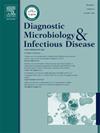Peripheral blood lymphocyte subsets combined with fungal biomarkers in the diagnosis of invasive fungal infections complicated by sepsis
IF 2.1
4区 医学
Q3 INFECTIOUS DISEASES
Diagnostic microbiology and infectious disease
Pub Date : 2025-01-16
DOI:10.1016/j.diagmicrobio.2025.116694
引用次数: 0
Abstract
Objective
To evaluate the lymphocyte subpopulations and the levels of (1, 3)-β-d-glucan (BDG) and galactomannan (GAL) in sepsis patients with secondary invasive fungal infections (IFIs), and to investigate the association between lymphocytes and IFIs.
Methods
A retrospective case-control study of 47 patients with sepsis complicated by IFIs, 50 sepsis patients, and 50 healthy controls was conducted. The correlation between lymphocyte subsets and BDG, GAL levels was analyzed using the Spearman correlation method, and the diagnostic efficacy of IFIs-related factors was assessed using the receiver operating characteristic curve (ROC) analysis.
Results
The IFIs group exhibited significantly lower absolute lymphocyte counts (P < 0.05). The study revealed that both BDG and GAL levels were inversely correlated with the counts of total lymphocytes and CD4+ lymphocytes (BDG: R2 = 0.361, 0.283; GAL: R2 =0.257, 0.375, P < 0.05). The area under the curve (AUC) for the combined diagnostic markers was as follows: BDG and GAL alone had an AUC of 0.753; BDG and GAL in conjunction with lymphocyte count had an AUC of 0.921; and the combination of BDG, GAL, lymphocyte count, and CD4 T lymphocyte count achieved an AUC of 0.962. The sensitivities for these combinations were 80.00 %, 80.85 %, and 87.23 %, respectively, while the specificities were 60.00 %, 96.0 %, and 98.00 %, respectively.
Conclusions
The reduced absolute counts of lymphocyte subsets in patients with IFIs complicated by sepsis suggest a state of immunosuppression. The concurrent assessment of BDG, GAL, total lymphocyte count, and CD4 T lymphocyte count demonstrates high diagnostic efficacy for identifying IFIs complicated by sepsis.
外周血淋巴细胞亚群与真菌生物标志物联合诊断侵袭性真菌感染合并败血症
目的:评价脓毒症合并继发性侵袭性真菌感染(IFIs)患者淋巴细胞亚群及(1,3)-β-d-葡聚糖(BDG)、半乳甘露聚糖(GAL)水平,探讨淋巴细胞与IFIs的关系。方法:对47例脓毒症合并IFIs患者、50例脓毒症患者和50名健康对照者进行回顾性病例对照研究。采用Spearman相关法分析淋巴细胞亚群与BDG、GAL水平的相关性,采用受试者工作特征曲线(ROC)分析评价ifis相关因素的诊断效果。结果:IFIs组淋巴细胞绝对计数明显降低(P < 0.05)。研究发现,BDG和GAL水平与总淋巴细胞和CD4+淋巴细胞计数呈负相关(BDG: R2 = 0.361, 0.283;Gal: r2 =0.257, 0.375, p < 0.05)。联合诊断标志物的曲线下面积(AUC)为:BDG和GAL单独的AUC为0.753;BDG和GAL与淋巴细胞计数的AUC为0.921;BDG、GAL、淋巴细胞计数和CD4 T淋巴细胞计数联合测定,AUC为0.962。这些组合的敏感性分别为80.00 %、80.85%和87.23%,特异性分别为60.00 %、96.0%和98.00%。结论:IFIs合并脓毒症患者淋巴细胞亚群绝对计数降低提示免疫抑制状态。同时评估BDG、GAL、总淋巴细胞计数和CD4 T淋巴细胞计数对IFIs合并脓毒症具有较高的诊断效果。
本文章由计算机程序翻译,如有差异,请以英文原文为准。
求助全文
约1分钟内获得全文
求助全文
来源期刊
CiteScore
5.30
自引率
3.40%
发文量
149
审稿时长
56 days
期刊介绍:
Diagnostic Microbiology and Infectious Disease keeps you informed of the latest developments in clinical microbiology and the diagnosis and treatment of infectious diseases. Packed with rigorously peer-reviewed articles and studies in bacteriology, immunology, immunoserology, infectious diseases, mycology, parasitology, and virology, the journal examines new procedures, unusual cases, controversial issues, and important new literature. Diagnostic Microbiology and Infectious Disease distinguished independent editorial board, consisting of experts from many medical specialties, ensures you extensive and authoritative coverage.

 求助内容:
求助内容: 应助结果提醒方式:
应助结果提醒方式:


